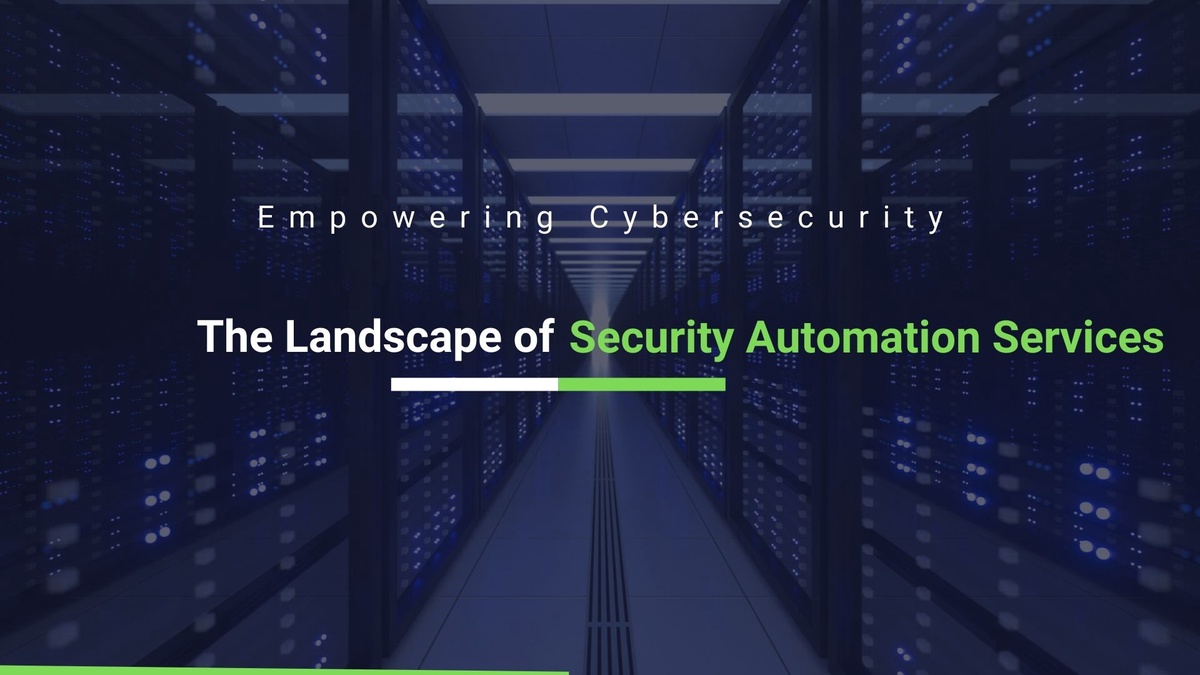In the ever-evolving digital landscape, organizations face a relentless barrage of cyber threats. The sheer volume and sophistication of these attacks have rendered traditional security measures inadequate, necessitating a shift toward automation. Security automation services have emerged as a powerful tool to combat cyber threats, offering a proactive and scalable approach to safeguarding digital assets.
The cybersecurity landscape is characterized by constant evolution, with new threats emerging at an alarming pace. Cybercriminals are becoming increasingly adept at exploiting vulnerabilities and employing sophisticated techniques to infiltrate networks and steal sensitive data.
- Dynamic Threat Landscape: The cybersecurity field faces constant evolution, marked by the rapid emergence of new threats. Cybercriminals exploit vulnerabilities using sophisticated techniques, demanding a security posture that can adapt to these challenges.
- Overwhelming Cyber Threats: The volume and complexity of cyber threats make manual security processes unsustainable. Security teams grapple with numerous alerts, struggling to match the pace of the evolving threat landscape.
Automation becomes pivotal in this scenario. By automating repetitive tasks and utilizing intelligent threat detection mechanisms, security automation services play a crucial role in enhancing an organization's cybersecurity posture. This article delves into the world of security automation services, exploring their role, impact, and potential to revolutionize cybersecurity.
Understanding Security Automation Services
Security automation refers to the use of technology to automate security tasks, processes, and responses. It encompasses a range of tools and techniques that streamline security operations, enhance threat detection and response, and optimize resource allocation.
How Automation Complements Traditional Cybersecurity Measures
Security automation complements traditional cybersecurity measures by automating repetitive and time-consuming tasks, allowing security teams to focus on more strategic and critical aspects of cybersecurity. It also enhances the efficiency and accuracy of security operations, enabling faster and more effective responses to cyber threats.
Real-world Examples of Security Automation in Action
- Automated Log Analysis: Security automation can analyze vast amounts of log data to identify anomalies and potential threats, significantly reducing the time spent on manual log review.
- Automated Patch Management: Automation can streamline patch deployment, ensuring that systems are kept up to date with the latest security patches, reducing vulnerability risk.
- Automated Threat Detection and Response: Automation can detect and respond to threats in real-time, isolating infected systems, blocking malicious traffic, and preventing further damage.
Key Components of Security Automation
#1. Threat Intelligence Integration
Security automation services integrate threat intelligence feeds to gain real-time insights into emerging threats and attack patterns, enabling proactive threat mitigation and prevention.
#2. Automated Incident Detection and Response
Automation can analyze security alerts, identify potential incidents, and initiate predefined response actions, such as quarantining infected devices or blocking malicious traffic.
#3. Security Orchestration for Streamlined Workflows
Automation platforms can orchestrate complex security workflows, automating the coordination of disparate security tools and processes, improving efficiency and reducing manual intervention.
#4. Continuous Monitoring and Adaptive Learning
Automation can enable continuous monitoring of security posture, identifying potential vulnerabilities and adapting security measures accordingly, providing real-time protection against evolving threats.
Benefits of Security Automation Services
- Increased Efficiency and Response Speed: Automation significantly reduces the time spent on manual security tasks, allowing security teams to respond to threats faster and more effectively.
- Reduction in Human Error and Repetitive Tasks: Automation eliminates human error and the burden of repetitive tasks, improving overall security posture and reducing the risk of security breaches.
- Scalability for Handling a Growing Volume of Cyber Threats: Automation can scale to handle increasing volumes of security alerts and events, ensuring effective protection as the threat landscape expands.
- Cost-effectiveness and Resource Optimization: Automation optimizes resource allocation by reducing the need for manual labor, allowing organizations to redirect resources to more strategic security initiatives.
Integration of AI in Security Automation
The integration of Artificial Intelligence (AI) plays a crucial role in enhancing security automation capabilities.
Role of Artificial Intelligence in Enhancing Automation
- Machine learning algorithms can analyze vast datasets and identify patterns to predict and anticipate threats, enabling proactive cybersecurity strategies.
- AI can automate threat hunting and investigation by analyzing security events and identifying anomalies that could indicate potential attacks.
- Natural language processing allows for understanding and analyzing textual cybersecurity data such as emails and logs for better threat detection and response.
Machine Learning for Adaptive and Predictive Security Measures
- Adaptive security measures can learn and adjust based on new data and attack patterns, creating a more agile and resilient cybersecurity posture.
- Predictive security measures anticipate potential threats based on historical events and real-time threat intelligence, enabling preventive measures to be deployed before attacks occur.
Advancements in AI-driven Threat Detection and Analysis
- AI can analyze large volumes of data from various sources to detect sophisticated threats that traditional methods might miss.
- AI-powered threat intelligence platforms automatically gather and analyze threat data, providing actionable insights to security teams for proactive defense.
Future Trends in Security Automation Services
- Blockchain technology can be used to create immutable and tamper-proof logs of security events, enhancing transparency and accountability within organizations.
- Quantum computing has the potential to revolutionize encryption and decryption techniques, posing new challenges and opportunities for cybersecurity.
- The adoption of security automation is expected to increase significantly as organizations recognize its importance in a complex threat landscape.
- Automation will become even more integrated with existing security infrastructure and processes, leading to a more holistic and automated approach to cybersecurity.
- Automation will be crucial in addressing the increasing sophistication of cyber threats, including zero-day vulnerabilities and advanced persistent threats.
- AI-powered automation will allow for continuous analysis and adaptation of security measures to anticipate and counter emerging threats promptly.
Conclusion
Security automation services have revolutionized the way organizations approach cybersecurity. By integrating tools, best practices, and artificial intelligence, automation empowers organizations to bolster their defenses against the ever-growing wave of cyber threats.
Frequently Asked Questions (FAQs)
Question 1: What are the biggest challenges associated with implementing security automation?
- The biggest challenge is ensuring proper configuration and monitoring of automated processes to avoid false positives and negatives.
- Integrating with existing security infrastructure and managing change within the organization can also be challenging.
Question 2: How can organizations ensure continuous improvement of their security automation strategy?
- Regularly analyze the effectiveness of the implemented automation, fine-tune configurations, and update tools as needed.
- Invest in continuous upskilling and training for cybersecurity teams to remain at the forefront of automation technology.
Question 3: What resources are available to help organizations implement security automation?
- Several vendors offer security automation solutions and services tailored to meet rôzne organizational needs.
- Security conferences and training programs provide valuable insights and best practices for implementing and optimizing security automation.
Question 4: What are the long-term impacts of security automation on the cybersecurity landscape?
- Automation will continue to reshape the cybersecurity landscape, increasing efficiency and accuracy in identifying and responding to threats.
- AI-powered automation will play a crucial role in developing adaptive and proactive cybersecurity strategies, mitigating risks for organizations of all sizes.


No comments yet